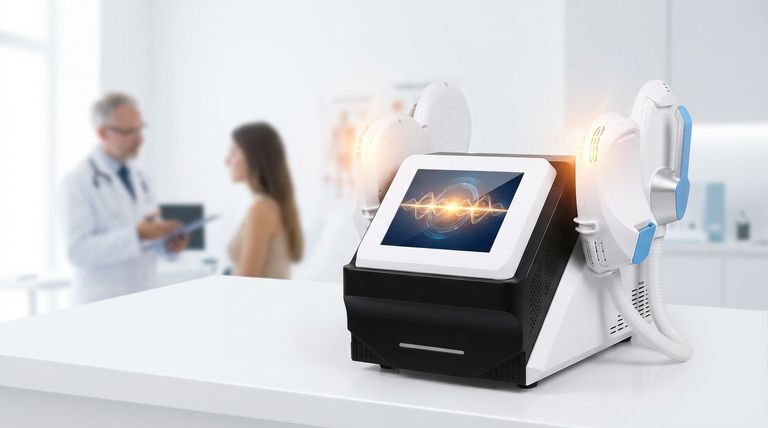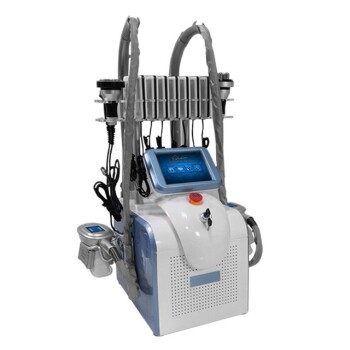At its core, the primary, scientifically established effect of radiofrequency (RF) radiation on the human body is heating. When absorbed in large enough amounts, this energy causes molecules in body tissue to vibrate, generating heat. At extremely high power levels, far beyond those of everyday devices, this thermal effect can lead to burns and tissue damage.
The crucial distinction is that RF radiation is non-ionizing. Unlike X-rays or gamma rays, it does not have enough energy to break chemical bonds or damage DNA directly, which is the primary concern for cancer risk from other forms of radiation. Its danger is overwhelmingly related to heat.

The Fundamental Divide: Non-Ionizing vs. Ionizing Radiation
To understand RF's effect on the body, we must first distinguish between two fundamental types of radiation. This distinction is the single most important concept for evaluating risk.
The Energy of Radiation
All radiation exists on a spectrum of energy. The key threshold is the energy required to knock an electron from an atom or molecule—a process called ionization.
Ionizing Radiation (e.g., X-rays, Gamma Rays)
This is high-energy radiation. Its ability to strip away electrons allows it to break chemical bonds within biological cells, including the DNA that acts as our genetic blueprint. This DNA damage is the mechanism that can lead to mutations and increase cancer risk.
Non-Ionizing Radiation (e.g., RF, Microwaves, Visible Light)
This is low-energy radiation. RF energy is not powerful enough to ionize atoms. Instead of breaking bonds, its main interaction with the body is to cause molecules—particularly water—to vibrate. This vibration produces heat. A microwave oven is a perfect example, using high-power RF to heat food rapidly.
RF's Main Effect: Thermal Heating
Because RF radiation is non-ionizing, its only confirmed harmful effect at high power is thermal.
How RF Creates Heat
The human body is about 60% water. When exposed to RF fields, these water molecules try to align with the oscillating field, causing them to rotate and bump into each other. This friction generates heat throughout the exposed tissue.
When Does Heating Become Dangerous?
Your body has effective cooling mechanisms, primarily blood flow, to dissipate excess heat. However, very high levels of RF exposure can generate heat faster than your body can remove it. This can raise tissue temperature to a point where burns and cellular damage occur.
The Power Level Is Key
The thermal effect is entirely dependent on the intensity and duration of the exposure. The power levels required to cause harmful heating are orders of magnitude higher than those emitted by consumer electronics like cell phones, Wi-Fi routers, and Bluetooth devices.
Understanding the Trade-offs and Common Concerns
The public conversation about RF safety is often not about high-power burns, but about the potential for long-term health effects from low-power devices.
The Question of Long-Term, Low-Level Exposure
The primary concern voiced by the public and studied by scientists is whether chronic, low-level RF exposure—even if it doesn't cause noticeable heating—could lead to adverse health effects like cancer.
The Scientific and Regulatory Consensus
Major international health and safety organizations (like the WHO, FDA, and ICNIRP) have consistently concluded that there is no established causal link between RF exposure below established safety limits and any adverse health effect. Decades of research have not proven that RF from devices like phones causes cancer.
The IARC "Group 2B" Classification
In 2011, the International Agency for Research on Cancer (IARC) classified RF radiation as "Group 2B: Possibly carcinogenic to humans." This classification often causes confusion. It does not mean RF is proven to cause cancer.
It means the evidence is limited, and a causal link cannot be completely ruled out. For context, other substances in Group 2B include aloe vera extract, pickled vegetables, and coffee. The classification signifies a low level of evidence and highlights an area for continued research.
How Safety Standards Protect You
To prevent the only confirmed harm—tissue heating—regulatory bodies have established clear safety limits.
The Role of Specific Absorption Rate (SAR)
Specific Absorption Rate (SAR) is the standard unit of measurement for the amount of RF energy absorbed by the body. It is measured in watts per kilogram (W/kg).
Setting Conservative Limits
Regulatory agencies like the Federal Communications Commission (FCC) in the United States mandate a maximum SAR limit for mobile devices. This limit is set far below the level at which any harmful heating has ever been observed in laboratory studies. The standards have a very large built-in safety margin to account for all users in all conditions.
Making the Right Choice for Your Goal
Your approach to RF exposure should be guided by your specific context and goals.
- If your primary focus is safety from everyday devices (phones, Wi-Fi): The established international safety limits are designed to prevent the only proven harm (heating) with a significant margin of safety.
- If you remain concerned about unproven long-term risks: You can easily reduce your exposure by using a headset or speakerphone during calls and keeping your phone at a distance when possible.
- If you work near high-power RF emitters (e.g., broadcast antennas, radar systems): You must follow strict occupational safety guidelines, as the risk of severe thermal injury from high-intensity RF fields is real and well-understood.
Understanding the distinction between thermal effects and ionization risk is the key to navigating the topic of RF safety with confidence.
Summary Table:
| RF Radiation Effect | Key Takeaway |
|---|---|
| Primary Effect | Thermal heating (tissue vibration) |
| Cancer Risk | Non-ionizing; no proven link below safety limits |
| Key Safety Metric | Specific Absorption Rate (SAR) |
| Regulatory Consensus | No established harm from devices like phones/Wi-Fi |
BELIS specializes in professional medical aesthetic equipment, serving medical aesthetics clinics and premium beauty salons.
If you are a clinic or salon owner considering RF-based aesthetic devices, understanding the science behind safe and effective energy delivery is crucial. Our equipment is engineered to deliver precise, controlled RF energy for optimal results while adhering to the highest safety standards.
Let us help you choose the right technology for your practice and ensure the safest, most effective treatments for your clients. Contact BELIS today for a professional consultation.
Visual Guide

Related Products
- EMSlim Body Sculpting Machine EMS Body Slimming Machine
- Ultrasonic Cavitation Radiofrecuency Machine for Body Slimming
- EMS Body Sculpting Slimming Machine EMSlim Body Slimming Machine
- EMSlim RG Laser Body Sculpting and Slimming Machine
- Cryolipolysis Fat Freezing Machine Ultrasonic Cavitation Fat Reducing Device
People Also Ask
- How often can I use ultrasonic cavitation at home? A Safe & Effective Schedule
- What are the side effects of ultrasound fat burning? A Guide to Safe Body Contouring
- Is EMSlim safe? Ensuring Your Safety in Non-Invasive Body Contouring
- Does EMS sculpting really work? Achieve Clinically-Proven Body Contouring
- What are the side effects of ultrasound fat reduction? Minimize Risks for Safe Body Contouring



















